Hello, this is my first post on this forum. I have been reading a lot and trying to design a fullrange system for my 10' x 14' sitting room. I'm impressed with how helpful everyone is on here and decided to register and see if I could get some opinions and suggestions on my overall plan.
As indicated, I have a pair of the Tang Band W5 -1611SA that I will be building cabinets for. Right now they are being broken in sitting in some ~.35 ft^3 ported junk boxes that happened to have the right hole in them. I have a Dayton T amp with 30w/ch and the source is my laptop with an equalizer in the soundcard program. I have the speakers wired directly to the amp.
My adjustments on the equalizer are flat from 1K up and a gradual boost from 500 down ending at +6 at 32hz. This is just by ear, an untrained pair at that. Is what I am doing here similar to a baffle step compensation? If so, is this a better way to do it?
I plan to make the enclosure .6 cubic feet and tune a port to 55hz. It will probably follow the golden ratio and the driver will be in the top half of the narrow/tall side. I intend to put a gentle radius (3/4"?) on the two vertical, front corners.
Am I on the right track for getting accurate sound that is fun to listen to? Should I think about impedence compenstaion, BSC? other things? I like the idea of not having any crossover components, but in the end, how it sounds should determine if I use any components between the amp and speaker...I think.
Thanks- Adam
As indicated, I have a pair of the Tang Band W5 -1611SA that I will be building cabinets for. Right now they are being broken in sitting in some ~.35 ft^3 ported junk boxes that happened to have the right hole in them. I have a Dayton T amp with 30w/ch and the source is my laptop with an equalizer in the soundcard program. I have the speakers wired directly to the amp.
My adjustments on the equalizer are flat from 1K up and a gradual boost from 500 down ending at +6 at 32hz. This is just by ear, an untrained pair at that. Is what I am doing here similar to a baffle step compensation? If so, is this a better way to do it?
I plan to make the enclosure .6 cubic feet and tune a port to 55hz. It will probably follow the golden ratio and the driver will be in the top half of the narrow/tall side. I intend to put a gentle radius (3/4"?) on the two vertical, front corners.
Am I on the right track for getting accurate sound that is fun to listen to? Should I think about impedence compenstaion, BSC? other things? I like the idea of not having any crossover components, but in the end, how it sounds should determine if I use any components between the amp and speaker...I think.
Thanks- Adam
Have a look at this for a "turnkey" design with the W5-1611:
http://flogatt.kilu.de/Hifi-Forum/Sarah von FloGatt.pdf
/U.
http://flogatt.kilu.de/Hifi-Forum/Sarah von FloGatt.pdf
/U.
At FullRangeMan's suggestion we got a pair of these to try in Frugel-Horn Mk3. They work very well. The drivers themselves have a bit of a plasticy colouration, i will be seeing if i can remdy that.
Nisbeth, that project has a very German approach to a box... a zillion notch filters.
dave
Nisbeth, that project has a very German approach to a box... a zillion notch filters.
dave
At FullRangeMan's suggestion we got a pair of these to try in Frugel-Horn Mk3. They work very well.
dave
Another driver for the FH Mk3?
Another driver for the FH Mk3?What exactly is plasticy coloration - A slight lack of "naturalness" vs paper? How is the detail level?
I'm just guessing a toy box kind of sound. hehe
Another driver for the FH Mk3?What exactly is plasticy coloration - A slight lack of "naturalness" vs paper? How is the detail level?
polypropylene cones do color a bit different than the colouration of the paper or paper-like cones (which in my opinion color just as well) as used by many FR drivers.
The idea of the filter in the linked plan is not bad: a potentiometer can be used to completely bypass it or to gradually select its impact.
Another driver for the FH Mk3?
Yes. It was mentioned a while back...
dave
I finally got the skil-saw and knocked together a couple of 3/4" MDF boxes...the speakers are really smooth even without any real damping and teetering on some flimsy stands. Can't wait to veneer them and properly line the walls. I'm using a 2 inch precision port on the rear tuned to 50hz which I think gives me a little dip at 60 until I shorten it.
The detail especially in the bass and mid bass is pretty stunning. Imaging is very solid if you are in the sweet spot. Not sure if I can deal with how directional the highs are though. Might have to make these a two way setup at some point. Wondering how high I can cross a tweeter and still enjoy more dispersion?
I mixed up some latex caulking and steel shot from a shot blaster to add some mass to the walls. Knuckle wrap test says "yes", not sure what it will sound like. The plan is to glue thin felt on the sides and some open cell ribbed foam to the back wall.
The detail especially in the bass and mid bass is pretty stunning. Imaging is very solid if you are in the sweet spot. Not sure if I can deal with how directional the highs are though. Might have to make these a two way setup at some point. Wondering how high I can cross a tweeter and still enjoy more dispersion?
I mixed up some latex caulking and steel shot from a shot blaster to add some mass to the walls. Knuckle wrap test says "yes", not sure what it will sound like. The plan is to glue thin felt on the sides and some open cell ribbed foam to the back wall.
Attachments
-
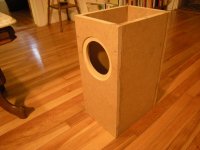 DSCN8720 (1024x768).jpg188.1 KB · Views: 1,502
DSCN8720 (1024x768).jpg188.1 KB · Views: 1,502 -
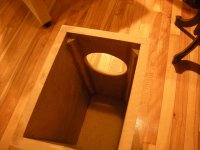 DSCN8721 (1024x768).jpg192.9 KB · Views: 1,410
DSCN8721 (1024x768).jpg192.9 KB · Views: 1,410 -
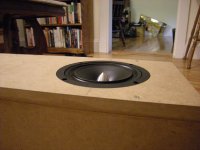 DSCN8722 (1024x768).jpg193.9 KB · Views: 1,392
DSCN8722 (1024x768).jpg193.9 KB · Views: 1,392 -
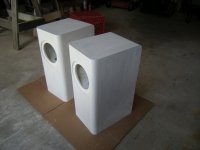 DSCN8773 (1024x768).jpg116.3 KB · Views: 1,396
DSCN8773 (1024x768).jpg116.3 KB · Views: 1,396 -
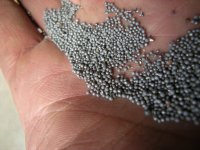 DSCN8777 (1024x768).jpg209.7 KB · Views: 1,394
DSCN8777 (1024x768).jpg209.7 KB · Views: 1,394 -
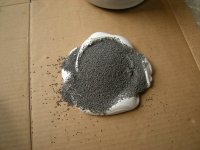 DSCN8778 (1024x768).jpg222 KB · Views: 345
DSCN8778 (1024x768).jpg222 KB · Views: 345 -
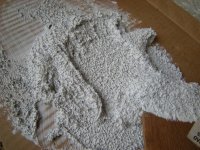 DSCN8780 (1024x768).jpg262.8 KB · Views: 347
DSCN8780 (1024x768).jpg262.8 KB · Views: 347
it would be better that you have used something else than MDF, because this material is only good for bass, the beaming problem can be solved adding a rear firing tweeter ambience enhancer  just XO it high with condensator 6db per octave
just XO it high with condensator 6db per octave 
here is good aproach for sandwich
http://www.hifi-selbstbau.de/index.php?option=com_content&view=article&id=416
here is good aproach for sandwich
http://www.hifi-selbstbau.de/index.php?option=com_content&view=article&id=416
Last edited:
it would be better that you have used something else than MDF, because this material is only good for bass,...
afaiu mdf has great damping properties against resonances in the walls, so isn't that ideal?
the idea of lining the insides of the cabinet (at least 2/3 of the area) with a sandwich of ~4mm bitumen and 2mm aluminum/3-4mm hdf board seems to produce excellent results!
thats planned for my next speaker build
afaiu mdf has great damping properties against resonances in the walls, so isn't that ideal?
It is all a myth.... the MDF part
dave
why is that?
afaiu mdf has great damping properties against resonances in the walls, so isn't that ideal?
the idea of lining the insides of the cabinet (at least 2/3 of the area) with a sandwich of ~4mm bitumen and 2mm aluminum/3-4mm hdf board seems to produce excellent results!
thats planned for my next speaker build
without venturing into the polemics, might I suggest you try something different on your next project - ie lighter / stiffer material with strategic bracing, no mass loading of panels, and "damping" (absorbent padding) of interior
high quality plywood ("Baltic" / Russian Birch etc), or if you're confident with your skills, solid woods such as Cedar, Fir, Pine, or local favorites
then you'll know for yourself if proponents of this approach are on to something
I wonder how side firing tweeters would work? Top firing? My side walls are 6 times closer that the rears where these speakers have to live. I have some Audax domes from the mid 1990s that I will try in some different positions once I get some capacitors to play with. If that doesn't satisfy I might scrap this and try something else. I need to be able to slide my chair over three inches and not have it sound like I put on a mad bomber hat
Last edited:
... might I suggest you try something different on your next project - ie lighter / stiffer material with strategic bracing, no mass loading of panels, and "damping" (absorbent padding) of interior
...
afaiu very hard + unflexibale walls push the resonances up to frequencies that are more bothersome. i read in german forums about the extreme bracing for sub and bass enclosures.
bare walls/no stuffing? what about the standing waves (modes?) in the enclosure?
afaiu very hard + unflexibale walls push the resonances up to frequencies that are more bothersome. i read in german forums about the extreme bracing for sub and bass enclosures.
bare walls/no stuffing? what about the standing waves (modes?) in the enclosure?
Please don't get the MDF/BB wars started again. I have surrendered.
The thing is you want the wall resonances out of the pass band of the cabinet. If the cabinet is only working for the first few 100's of Hz, it is very easy to get the wall resonance up above that by making it light and stiff. The bracing in a sub has nothing to do with cabinet resonance. A sub is braced to prevent the walls from moving in and out due to the pressure inside the cabinet.
I believe that most cabinet bracing is ill conceived. Multiple window braces help reduce the size of a vibrating panel and hence raise the resonant frequency of the panel, but braces along the length of the panel will make it far stiffer then window braces. I believe that a 12mm panel with a 18mm x 50mm longitudinal brace will outperform an 18mm panel. I will be trying this in the next few months.
Bob
... but braces along the length of the panel will make it far stiffer then window braces
+1
afaiu very hard + unflexibale walls push the resonances up to frequencies that are more bothersome. i read in german forums about the extreme bracing for sub and bass enclosures.
bare walls/no stuffing? what about the standing waves (modes?) in the enclosure?
If that's directed at me, I didn't say bare walls (although many types of horns frequently are except for the area immediately proximate to the driver) , and the degree of stuffing depends on design.
As Bob notes, and DaveD has espoused for years, a light/stiff/strategically braced enclosure (of whatever material) can have individual panel areas that resonate at multiple frequencies, each well above those at which the enclosure "is working" - the several hundred hertz. Such enclosures tend to be far less energized, and moreover dissipate that energy much faster.
Yes, subs do benefit from sturdy bracing, and to a degree some mass helps, just to keep the damn boxes from walking across the floor or disintegrating.
ok. no starting of a "war" intended, just curiose for more input on the subject.
the tang band w5-1620sa for example...
i'm building cabs for a fr driver(chp-70). multiplex (birch) 15mm. ~11l volume vented. 15mm felt on the upper half of walls, top + back. mainly to reduce reflections back through the cone.
due to the cab dimensions the first standing wave would be about 350hz.
i read about and listend to vented speakers with an "acoustic swamp" in the bottom of the cabinet to swollow the standing wave (glas- or rockwoll covered by somer polystuffing or foam.
and all this is not wanted/needed? just bare walls?
what about fr cabinets? above what pass band then?...The thing is you want the wall resonances out of the pass band of the cabinet. If the cabinet is only working for the first few 100's of Hz, it is very easy to get the wall resonance up above that by making it light and stiff. The bracing in a sub has nothing to do with cabinet resonance. A sub is braced to prevent the walls from moving in and out due to the pressure inside the cabinet.
the tang band w5-1620sa for example...
i'm building cabs for a fr driver(chp-70). multiplex (birch) 15mm. ~11l volume vented. 15mm felt on the upper half of walls, top + back. mainly to reduce reflections back through the cone.
due to the cab dimensions the first standing wave would be about 350hz.
i read about and listend to vented speakers with an "acoustic swamp" in the bottom of the cabinet to swollow the standing wave (glas- or rockwoll covered by somer polystuffing or foam.
and all this is not wanted/needed? just bare walls?
Last edited:
Actually, if you have a standing wave, the worst place to put the damping is at the top or bottom. At these points the standing wave is high pressure and zero velocity. In the middle of the box where the wave is low pressure, high velocity is the place to put the damping. When I do a MLTL, I do line the walls with fiberglass. That works in a 40" pipe, but when doing a BR. I use polyester wadding lightly packed throughout the box.
As far as the bandwidth issue, the box is going to stop contributing Helmholtz resonance by 200-300Hz. Above that frequency, the box acts as an infinite baffle. any vibrations contributed by the driver should be absorbed in its suspension.
Bob
As far as the bandwidth issue, the box is going to stop contributing Helmholtz resonance by 200-300Hz. Above that frequency, the box acts as an infinite baffle. any vibrations contributed by the driver should be absorbed in its suspension.
Bob
Last edited:
- Status
- This old topic is closed. If you want to reopen this topic, contact a moderator using the "Report Post" button.
- Home
- Loudspeakers
- Full Range
- Simple 5" Tang Band W5-1611SA project ideas...